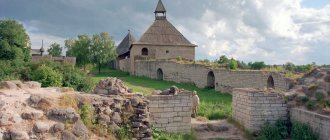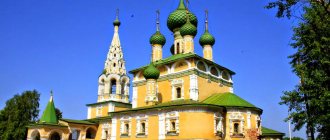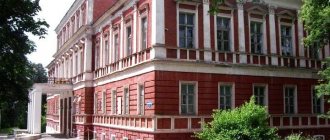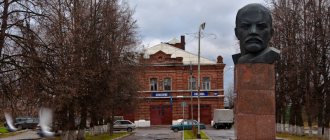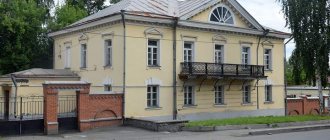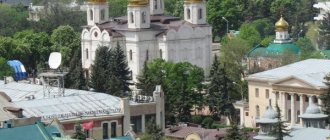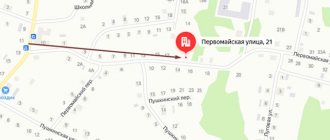Staraya Ladoga is referred to as the first capital of Rus' and is one of the oldest settlements in Russia.
Staraya Ladoga is located 150 km from St. Petersburg in the Leningrad region on the banks of the Volkhov River. Today, in terms of the number of ancient architecture of the 9th-19th centuries, it surpasses many Russian cities. Also here you can admire not only the architecture, but also enjoy the wonderful beauty of the landscapes and feel the spirit of antiquity. Now it is a village of 2000 people, but previously this place was the most important trading point.
If you drive 15 km up the river, you will see Novaya Ladoga, a town with a population of 9,000 people, which was founded in 1704 by Peter the Great to support the life of a shipyard and organize food delivery during the Second World War.
See prices for hotels in Ladoga on Booking.com=>>
Staraya Ladoga Fortress
One of the main attractions of Staraya Ladoga is the Staraya Ladoga Fortress, which was founded at the end of the 9th century.
The fortress was originally built from wood, but this seemed ineffective and so the fortress was rebuilt from stone for greater hardness. It was very important because it protected the entire waterway. Today it houses a museum that houses many different exhibits.
My impressions of Novaya Ladoga
Novaya Ladoga made an ambivalent impression on me. On the one hand, there is a beautifully planned city, a wide main street, the majestic Volkhov, canals, and the vast Lake Ladoga. But many buildings are dilapidated and require repairs. I think if it gets cleaned up it will become a popular tourist spot.
Wooden house in Novaya Ladoga
Entrance in a wooden house
Volkhov in Novaya Ladoga
Ships on the Volkhov in Novaya Ladoga
Mouth of the Volkhov
Ships near Volkhov
Arrow at the mouth of the Volkhov
Volkhov
Wooden house in Novaya Ladoga
Houses in Ladoga region
© Website “On the Roads of the Middle Way”, 2009-2021. Copying and reprinting of any materials and photographs from the site anashina.com in electronic publications and printed publications is prohibited.
Caves
See prices for hotels in Ladoga on Booking.com=>>
Staraya Ladoga is famous not only for its Architecture; there is something else, but no less interesting. These are caves. In old Ladoga there are as many as 2 dungeons. As is right, tourists who come to Staraya Ladoga always specially visit this place. These dungeons were created artificially. White sandstone was mined here, which was later used for glass production. Then the caves began to be used to study fossilized animals. There is one amazing place here, in one of the places at the farthest point of the cave the temperature is always 6 degrees Celsius. One of the dungeons has an underground lake with a depth of 0.5 meters, which never dries up.
Attention. To avoid getting lost, visit the cave only with experienced guides.
Novaya Ladoga: what to visit from temples and churches
Temples and cathedrals are an important component of the architectural complex of probably any Russian city and village. Novaya Ladoga is no exception; there are several churches and parishes that make for great photos, and you can always light a candle or pray inside.
Church of Clement of Rome and Peter of Alexandria
- Address: City quarter, Engels Ave., 10.
The first chronicle mentions of this temple date back to the 12th century, but this refers to a wooden church in Staraya Ladoga, which, according to the source, was founded thanks to the Novgorod Archbishop Nifont. The church was moved to Novaya Ladoga in 1704, as ordered by Tsar Peter.
Already by the 40s. In the 18th century, it became obvious that the building had fallen into disrepair, and a stone temple was built in its place. Its construction was financed by local merchant Dmitry Konstantinov. In terms of its architectural appearance, the building stood out sharply against the background of the then dominant lush Baroque style.
The church turned out to be strict, modest and ascetic. In the 1820s. it was reconstructed again under the leadership of the architect Konstantin Fortunatov. Her creation is the bell tower, which appeared at the temple during that period. 1932 marked the end of religious history; it was closed by the Soviet authorities. Now the church is not active.
Cathedral of the Nativity of the Blessed Virgin Mary (formerly the Church of St. John the Evangelist)
- Address: ave. Karl Marx, 49.
The church, built in 1702, is still active. Initially it belonged to a monastery and was considered a refectory church; it was consecrated in honor of John the Theologian. It acquired its current name thanks to an extension - the chapel of the Nativity of the Blessed Virgin Mary, which appeared in 1733.
By that time, the monastery had already ceased to exist. In the 40s In the 19th century, they decided to rebuild the temple; the provincial architect Malinin prepared a reconstruction project. However, perestroika began only in the 1870s; the updated appearance of the temple was the work of the architect M.A. Shchurupova.
Next to the temple there is a bell tower with a pointed tower and a clock. She complemented the identical appearance of the Orthodox parish. The complex was closed during the Soviet era from 1938 to 1949, and was badly damaged during the war. Since 1954, it has continuously functioned as the Cathedral of the Nativity of the Blessed Virgin Mary.
Church of the Savior Not Made by Hands
- Address: City quarter.
The history of this church also began in Staraya Ladoga - back in 1161. It burned and was rebuilt in stone. After moving to Novaya Ladoga, it was reconstructed at the expense of the merchant S. Tretyakov. It served as a winter church at the Church of St. Clement. Closed during Soviet times. Not restored. Currently not valid.
St. George's Church
- Address: st. Suvorova, 12Zh.
Soldiers of the Suzdal regiment built a log church in 1764. Previously, it was sometimes called Suvorovskaya, in honor of the military leader who commanded the regiment, although it was officially consecrated in honor of Peter and Paul.
The Peter and Paul Church became St. George's Church at the beginning of the 19th century. In the 1860s, a bell tower was erected, and one of the chapels of the church was built of stone. While remaining partially wooden, the church was damaged in a fire. The stone part has survived to this day, but needs reconstruction. How the church doesn't function.
Alexander Nevsky Church
- Address: st. Proletarsky Kanal, 20.
This brick building, formerly a church, today lacks domes and a bell tower. It continues to deteriorate and does not function. The temple began its history as a prison church for prisoners of the Novoladozhsk military prison.
It was erected at the turn of the 60-70s. XIX century, during the reign of Emperor Alexander II. They decided to consecrate the church in honor of the holy prince, who was considered the patron saint of the current monarch. It is considered a cultural heritage site of regional significance.
Nikolo-Medvedsky Monastery
In Novaya Ladoga, there are also many attractions that are worth visiting. One of them is the Nikolo-Medvedsky Monastery. It was founded in the 15th century and in 1583 was dilapidated at the hands of German knights. At the height of the Northern War in 1702, by order of Peter 1, the monastery was surrounded by an earthen rampart and ditches for protection purposes. Currently, only part of the remains have been preserved.
History of Novaya Ladoga
New Ladoga did not arise out of nowhere. , the Nikolo-Medvedsky (Nikolo-Medvedovsky) monastery was founded on the Medvedets Peninsula . It became a kind of border fortress; its defenders more than once repelled attacks from foreigners.
The snow-white spire of the bell tower of the Nikolo-Medvedsky Monastery is visible from afar. An earthen rampart with the remains of a ditch, the Church of St. John the Evangelist with the chapel of the Nativity of the Virgin Mary and a bell tower from the mid-18th century, and St. Nicholas Cathedral have been preserved.
Bell tower of the Nikolo-Medvedsky Monastery
In 1702, a shipyard was founded at the mouth of the Volkhov, where more than 2 thousand shipwrights were brought from the North.
Ships on Volkhov
After the founding of Novaya Ladoga in 1704, many residents of Ladoga moved here by order of the tsar, which from now on became known as Staraya Ladoga and lost its status as a city. Several infantry regiments were also stationed here. In 1727, Novoladozhsky district was founded, which was first part of the Novgorod province of the Novgorod province, and from 1781 - into the St. Petersburg province.
In 1719, construction of the Petrovsky Canal . In 1861-1866, parallel to it, almost along the shore of Lake Ladoga, a new canal was dug, with a total length of 110 km, and the old one received the prefix “old”. Currently, it is almost completely overgrown and dry; open areas remain only in Shlisselburg and Novaya Ladoga.
Novoladozhsky Canal
Novaya Ladoga is also associated with the name of Generalissimo A.V. Suvorov, who in 1763-69 commanded the Suzdal Infantry Regiment here and wrote “The Regimental Institution” - a theory of the education and training of soldiers.
Novaya Ladoga became an important strategic point during the Great Patriotic War. The Red Banner Ladoga Military Flotilla was based here , which ensured the functioning of the Road of Life - the only connection with besieged Leningrad. A huge boat on the shore, minesweeper No. 100, turned into a monument, reminds of those events. Alas, the local “craftsmen” did not spare him.
Hard times of war
During the Great Patriotic War, the city was the headquarters of the Ladoga Military Flotilla, which was part of the Baltic Fleet and provided the water “Road of Life” with besieged Leningrad under almost continuous enemy fire.
Military history of Ladoga
On October 22, 1942, a detachment of Italian marines, with massive fire support from a German flotilla of 30 ships and aircraft, attempted to capture Suho Island, located 20 km from the southern coast and the city of Novaya Ladoga. There is a lighthouse on the island and its location made it possible to control the waterway to Leningrad. The fierce battle lasted more than 4 hours, but the fighters of the Ladoga flotilla, showing courage, managed to repel the attack of a superior enemy and thereby saved the “Road of Life”.
The city is reminded of the difficult war years:
- Monument to the Ladoga Military Flotilla and the memorial complex “Road of Life” (Kirov Square) - which is a Finnish captured ship, re-equipped as a minesweeper and towing steamer “Kharkov”. During the war, these small ships, armed only with anti-aircraft machine guns, were part of the Ladoga military flotilla. Visitors are not limited in access, and they have the opportunity to enter any ship, stand on the deck, go down into the hold, climb the observation mast, pose at the anti-aircraft gun... Naturally, it is very popular with children, especially boys.
- A memorial plaque on the police department building (24 Karl Marx Avenue), informing that Admiral Cherokov, who commanded the Ladoga military flotilla during the war, lived here.
- Military burial and monument to Ladoga residents who died during the war (Suvorova St., 15) - 653 Soviet soldiers who died in the fight against fascism are buried in a mass grave. The names of 205 of them are still unknown. A native of the Ladoga region, hero of the Soviet Union, K.A. Peskov, was also reburied here.
Ladoga merchant
The favorable economic and geographical position of the city for a long time predetermined the main activity of Ladoga residents. Until 1917, it was a merchant city, which predetermined the architectural appearance and style of Novaya Ladoga. Nowadays, these regions would be called an “economically favored zone.”
Merchants' houses are of historical value
The legacy of those prosperous times left many merchant houses of both historical and architectural value. They, as a rule, differ both in their original appearance and in their unusual internal (circular) layout. Many of them now house various Ladoga administrative institutions: city administration, police department, fire department, music school, youth tourism and sailing center. Some are still used as residential buildings. Unfortunately, there are also abandoned buildings in a very neglected state.
In the two-story house of the merchant Nikitin, the Novoladozhsky Museum of History and Local Lore is located (Pionerskaya Street, building 16). The house has 8 halls, in which exhibits are divided into thematic areas and different eras of the history of the Ladoga region:
- Historical;
- Merchant;
- Ladies' lounge;
- Interior hall;
- Suvorovsky;
- Literary;
- Ethnographic;
- The road of life;
- Ladoga Military Flotilla.
Now the museum building is under restoration, and the museum's work is temporarily suspended. But local authorities promise that this is a short-term period. I would really like to believe it.
In the city center on Kirov Square is another reminder of the city's past economic prosperity. The Gostiny Dvor building, built in the mid-19th century and is a smaller copy of its “big brother” - also Gostiny Dvor, only in St. Petersburg. It is interesting that the building does not change its historical purpose - the premises of Gostiny Dvor are rented by local entrepreneurs for small shops and warehouses.
In 1913, opposite Gostiny Dvor, a monument to the Russian Tsar Alexander II, the “liberator,” was erected. However, just 5 years later, during the Civil War, the monument was demolished, and the new authorities immortalized A.M. Kirov on the surviving pedestal.
Ladoga temples
Church of Clement of Rome and Peter of Alexandria
Address: Karl Marx, 41
In the 18th century, a one-domed church was erected; in the 19th century, under the leadership of architect K. Fortunatov, a bell tower with a spire was added, which significantly changed the appearance of the temple. The church was closed in the early thirties. Now it is empty.
"Suvorov places"
From 1763 to 1769, the legendary commander A.V. Suvorov, who then commanded the Suzdal regiment, stationed in Novaya Ladoga since the end of the Northern War, lived in the city. Here he wrote the book “Regimental Establishment” - a methodological manual on the education and training of recruits in the army. Novaya Ladoga keeps several reminders of the stay of such an honored guest here:
- Officers' meeting building - officers of the Suzdal regiment and, in fact, Suvorov himself lived in this house. Unfortunately, the building was heavily damaged during a fire in the early 2000s and now has a very depressing appearance. The fact that this dilapidated building has a rich history can be guessed only by reading the information on the memorial plaque, carefully attached to the unburnt wall of the house.
- The building of the Suvorov barracks (Proletarsky Kanal street, building 12) - as you might guess, soldiers of the Suzdal Infantry Regiment were quartered here. Surprisingly, the building is still used as a residential building to this day.
- In addition, it was on Suvorov’s initiative that the chapel of St. George’s Church (10 Suvorov St.) was built in the city in 1764 in memory of the soldiers who died defending the Fatherland. Now it is being restored.
- There are also 2 monuments to the commander erected in the city - near the officers’ meeting building and next to Kirov Square.
Attractions
- House of Bolsheviks of Novoladozhsky district
- Church of Clement
- Church of the Savior Not Made by Hands
- Bust of A.V. Suvorov
- Minesweeper "TSH-100"
- Motor ship "Kharkov"
- Church ensemble
- Church fence with gate
- Memorial complex in honor of the sailors of the Ladoga Military Flotilla and river workers of the North-Western River Shipping Company, who guarded the water route of the “Road of Life” and provided transport links between besieged Leningrad and the country
- Gostiny Dvor
- House of Officers' Meeting of the Suzdal Infantry Regiment
- Nikolo-Medvedsky Monastery
- Headquarters of the Ladoga Military Flotilla
- St. Nicholas Cathedral
- Barracks of the former Suzdal regiment
- St. George's "Suvorov Church"
- Monument to A.V. Suvorov
- Staraya Ladoga Canal
- Monument to S. M. Kirov (installed on the pedestal of the monument to Emperor Alexander II (1913); opened on November 2, 1947, sketch by Z. M. Vilensky according to a standard model, authorship is erroneously attributed to sketch N. V. Tomsky)
- Locks of the Petrovsky mouth of the old canal
- Novoladozhsky Museum of Local Lore
- Monument to the Ladoga Military Flotilla
- Memorial plaque to the commander of the Ladoga military flotilla V. S. Cherokov
Links[edit]
Notes[edit]
- ^ abcdef Provincial Law No. 32-oz.
- ^ abcd Encyclopedia of Russian Cities
. Moscow: Great Russian Encyclopedia. 2003. p. 303. ISBN. 5-7107-7399-9. - ^ a b Federal State Statistics Service (2011). “All-Russian Population Census 2010. Volume 1" [All-Russian Population Census 2010, vol. 1]. All-Russian Population Census 2010 [All-Russian Population Census 2010]
. Federal State Statistics Service. - "26. The size of the permanent population of the Russian Federation by municipalities as of January 1, 2022". Federal State Statistics Service. Retrieved January 23, 2022.
- ^ abcd Law No. 56-oz.
- "On the Calculation of Time". Official Internet portal of legal information
. June 3, 2011. Retrieved January 19, 2022. - Post office. Information and computing center of OASU RPO. ( Post office
).
Search for postal service objects ( postal Search for objects
) (in Russian) - ↑
Federal State Statistics Service of Russia (May 21, 2004).
“The population of Russia, the constituent entities of the Russian Federation as part of federal districts, urban settlements, settlements, settlements is 3 thousand or more people” [Population of Russia, its federal districts, federal districts, districts Urban settlements, rural settlements - administrative centers and rural settlements with a population of over 3,000] (XLS). All-Russian Population Census 2002
. - “All-Union Population Census of 1989. The actual population of the union and autonomous republics, autonomous regions and districts, territories, negative phenomena, urban settlements and rural areasCulture of the Leningrad Region.” Retrieved March 18, 2014.
- ^ abcd “Archival copy” Novoladozhsky district (1917 - February 1923), Volkhovsky district (February 1923 - August 1927) (in Russian). System of classifiers of executive bodies of state power of St. Petersburg. Archived from the original on February 22, 2014. Retrieved March 18, 2014.CS1 maint: archived copy as title (link)
- ^ abcde “Archival copy” Volkhov district (August 1927) (in Russian). System of classifiers of executive bodies of state power of St. Petersburg. Archived from the original on March 17, 2014. Retrieved March 18, 2014.CS1 maint: archived copy as title (link)
- Monuments of history and culture of the peoples of the Russian Federation (in Russian). Ministry of Culture of Russia. Retrieved June 2, 2016.

